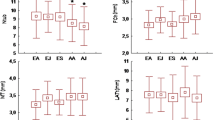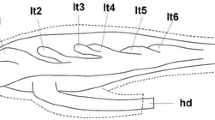Abstract
Sperm competition models on the evolution of sperm size assume associations with another sperm quality trait, sperm longevity. Sperm length can also provide an indication of possible mechanisms affecting motility and thus fertilization success. Despite their importance, however, detailed mechanisms of sperm competition at the gamete level are poorly understood. In simultaneously hermaphroditic land snails, sperm traits and cryptic female choice are assumed to be crucial in determining fertilization success. We examined the variation in sperm length and number among individuals from four natural populations of the land snail Arianta arbustorum, a species with multiple mating and long-term sperm storage. We also assessed variation in velocity, motility and longevity of sperm in snails from two of the four populations. Independent of shell size, sperm length differed among populations and, to a minor extent, even among individuals within populations. Mean sperm length of a snail was not correlated with the number of sperm delivered in a spermatophore. The mean sperm velocity (=VCL) did not differ between snails from two populations. However, VCL varied among snails. Percentage motility and longevity of sperm differed between snails from the two populations. No correlations were found between length, velocity, percentage motility and longevity of sperm. To conclude, individual snails differed in sperm quality, and this variation may partly explain the differential fertilization success between A. arbustorum snails. Moreover, our findings did not support the positive association between sperm length and longevity assumed by sperm competition models for internally fertilizing species.




Similar content being viewed by others
References
Anderson WA, Personne P (1976) The molluscan spermatozoon: dynamic aspects of its structure and function. Am Zool 16:292–313
Baer B, Schmid-Hempel P, Høeg JT, Boomsma JJ (2003) Sperm length, sperm storage and mating system characteristics in bumblebees. Insectes Soc 50:101–108
Baminger H, Haase M (2001) Spermatophore formation in the simultaneously hermaphroditic land snail Arianta arbustorum (Pulmonata: Stylommatophora: Helicidae). Neth J Zool 51:347–360
Baur B (1984) Shell size and growth rate differences for alpine populations of Arianta arbustorum (L.) (Pulmonata: Helicidae). Rev Suisse Zool 91:37–46
Baur B (1988a) Repeated mating and female fecundity in the simultaneously hermaphroditic land snail Arianta arbustorum. Invertebr Reprod Dev 14:197–204
Baur B (1988b) Population regulation in the land snail Arianta arbustorum: density effects on adult size, clutch size and incidence of egg cannibalism. Oecologia 77:390–394
Baur B (1990) Seasonal changes in clutch size, egg size and mode of oviposition in Arianta arbustorum L. (Gastropoda) from alpine populations. Zool Anz 225:253–264
Baur B (1994) Multiple paternity and individual variation in sperm precedence in the simultaneously hermaphroditic land snail Arianta arbustorum. Behav Ecol Sociobiol 35:413–421
Baur B (1998) Sperm competition in molluscs. In: Birkhead TR, Møller AP (eds) Sperm competition and sexual selection. Academic, London, pp 255–305
Baur B, Baur A (1992) Effect of courtship and repeated copulation on egg production in the simultaneously hermaphroditic land snail Arianta arbustorum. Invertebr Reprod Dev 21:201–206
Baur B, Raboud C (1988) Life history of the land snail Arianta arbustorum along an altitudinal gradient. J Anim Ecol 57:71–87
Baur B, Locher R, Baur A (1998) Sperm allocation in the simultaneously hermaphroditic land snail Arianta arbustorum. Anim Behav 56:839–845
Birkhead TR, Møller AP (1998) Sperm competition and sexual selection. Academic, London
Birkhead TR, Martinez JG, Burke T, Froman DP (1999) Sperm mobility determines the outcome of sperm competition in the domestic fowl. Proc R Soc Lond B 266:1759–1764
Birkhead TR, Pellatt EJ, Brekke P, Yeates R, Castillo-Juarez H (2005) Genetic effects on sperm design in the zebra finch. Nature 434:383–387
Bojat NC, Haase M (2002) Sperm storage in the simultaneously hermaphroditic land snail Arianta arbustorum. J Zool 258:497–503
Bojat NC, Sauder U, Haase M (2001) The spermathecal epithelium, sperm and their interactions in the hermaphroditic land snail Arianta arbustorum (Pulmonata, Stylommatophora). Zoomorphology 120:149–157
Bressac C, Hauschteck-Jungen E (1996) Drosophila subobscura females preferentially select long sperm for storage and use. J Insect Physiol 42:323–328
Burness G, Casselman SJ, Schulte-Hostedde AI, Moyes CD, Montgomerie R (2004) Sperm swimming speed and energetics vary with sperm competition risk in bluegill (Lepomis macrochirus). Behav Ecol Sociobiol 56:65–70
Chen XF, Baur B (1993) The effect of multiple mating on female reproductive success in the simultaneously hermaphroditic land snail Arianta arbustorum. Can J Zool 71:2431–2436
Dohmen MR (1983) Gametogenesis. In: Wilbur KM (ed) The Mollusca, vol 3. Academic, Orlando, pp 1–48
Froman D (2003) Deduction of a model for sperm storage in the oviduct of the domestic fowl (Gallus domesticus). Biol Reprod 69:248–253
Froman DP, Feltmann AJ, Rhoads ML, Kirby JD (1999) Sperm mobility: a primary determinant of fertility in the domestic fowl (Gallus domesticus). Biol Reprod 61:400–405
Froman DP, Pizzari T, Feltmann AJ, Castillo-Juarez H, Birkhead TR (2002) Sperm mobility: mechanisms of fertilizing efficiency, genetic variation and phenotypic relationship with male status in the domestic fowl, Gallus gallus domesticus. Proc R Soc Lond B 269:607–612
Gage MJG, Macfarlane C, Yeates S, Shackleton R, Parker GA (2002) Relationships between sperm morphometry and sperm motility in the Atlantic salmon. J Fish Biol 61:1528–1539
Gage MJG, Macfarlane CP, Yeates S, Ward RG, Searle JB, Parker GA (2004) Spermatozoal traits and sperm competition in Atlantic salmon: relative sperm velocity is the primary determinant of fertilization success. Curr Biol 14:44–47
Gomendio M, Roldan ERS (1991) Sperm competition influences sperm size in mammals. Proc R Soc Lond B 243:181–185
Hayashi F (1998) Sperm co-operation in the fishfly, Parachauliodes japonicus. Funct Ecol 12:347–350
Healy JM (1996) Molluscan sperm ultrastructure: correlation with taxonomic units within the Gastropoda, Cephalopoda and Bivalvia. In: Taylor J (ed) Origin and evolutionary radiation of the Mollusca. Oxford Univ Press, Oxford, pp 99–113
Hellriegel B, Blanckenhorn WU (2002) Environmental influences on the gametic investment of yellow dung fly males. Evol Ecol 16:505–522
Hofmann E (1923) Über den Begattungsvorgang von Arianta arbustorum (L.). Jena Z Med Naturwiss 59:363–400
Hosken DJ, Garner TWJ, Ward PI (2001) Sexual conflict selects for male and female reproductive characters. Curr Biol 11:489–493
Joly D, Cariou ML, Lachaise D (1991) Can sperm competition explain sperm polymorphism in Drosophila teissieri? Evol Biol 5:25–44
Karr TL, Pitnick S (1996) The ins and outs of fertilization. Nature 379:405–406
Katz DF, Drobnis EZ (1990) Analysis and interpretation of the forces generated by spermatozoa. In: Bavister BD, Cummins J, Roldan ERS (eds) Fertilization in mammals. Serono Symposia, Norwell, MA, pp 125–137
Kerney MP, Cameron RAD (1979) A field guide to the land snails of Britain and northwest Europe. Collins, London
Kubo-Irie M, Irie M, Nakazawa T, Mohri H (2003) Ultrastructure and function of long and short sperm in Cicadidae (Hemiptera). J Insect Physiol 49:983–991
Kupriyanova E, Havenhand JN (2002) Variation in sperm swimming behaviour and its effect on fertilization success in the serpulid polychaete Galeolaria caespitosa. Invertebr Reprod Dev 41:21–26
LaMunyon CW, Ward S (2002) Evolution of larger sperm in response to experimentally increased sperm competition in Caenorhabditis elegans. Proc R Soc Lond B 269:1125–1128
Lessells CM, Boag PT (1987) Unrepeatable repeatabilities: a common mistake. Auk 104:116–121
Lind H (1973) The functional significance of the spermatophore and the fate of spermatozoa in the genital tract of Helix pomatia (Gastropoda: Stylommatophora). J Zool 169:39–64
Locher R, Baur B (1997) A new technique to assess the number of spermatozoa in spermatophores of stylommatophoran gastropods. J Molluscan Stud 63:555–556
Locher R, Baur B (1999) Effects of intermating interval on spermatophore size and sperm number in the simultaneously hermaphroditic land snail Arianta arbustorum. Ethology 105:839–849
Locher R, Baur B (2000) Sperm delivery and egg production of the simultaneously hermaphroditic land snail Arianta arbustorum exposed to an increased sperm competition risk. Invertebr Reprod Dev 38:53–60
Locher R, Baur B (2002) Nutritional stress changes sex-specific reproductive allocation in the simultaneously hermaphroditic land snail Arianta arbustorum. Funct Ecol 16:623-632
Meisenheimer J (1912) Die Weinbergschnecke: Helix pomatia L. Klinkhardt LW, Leipzig
Michiels NK (1998) Mating conflicts and sperm competition in simultaneous hermaphrodites. In: Birkhead TR, Møller AP (eds) Sperm competition and sexual selection. Academic, London, pp 219-254
Miller GT, Pitnick S (2002) Sperm–female coevolution in Drosophila. Science 298:1230–1233
Moore PJ, Harris WE, Montrose VT, Levin D, Moore AJ (2004) Constraints on evolution and postcopulatory sexual selection: trade-offs among ejaculate characteristics. Evolution 58:1773–1780
Oppliger A, Naciri-Graven Y, Ribi G, Hosken DJ (2003) Sperm length influences fertilization success during sperm competition in the snail Viviparus ater. Mol Ecol 12:485–492
Parker GA (1993) Sperm competition games: sperm size and sperm number under adult control. Proc R Soc Lond B 253:245–254
Parker GA (1998) Sperm competition and the evolution of ejaculates: towards a theory base. In: Birkhead TR, Møller AP (eds) Sperm competition and sexual selection. Academic, London, pp 3–54
Parker GA, Begon ME (1993) Sperm competition games: sperm size and number under gametic control. Proc R Soc Lond B 253:255–262
Peng J, Chen S, Büsser S, Liu HF, Honegger T, Kubli E (2005) Gradual release of sperm bound sex-peptide controls female postmating behavior in Drosophila. Curr Biol 15:207–213
Pitnick S, Miller GT, Reagan J, Holland B (2001) Males’ evolutionary responses to experimental removal of sexual selection. Proc R Soc Lond B 268:1071–1080
Pitnick S, Miller GT, Schneider K, Markow TA (2003) Ejaculate-female coevolution in Drosophila mojavensis. Proc R Soc Lond B 270:1507–1512
Radwan J (1996) Intraspecific variation in sperm competition success in the bulb mite: a role for sperm size. Proc R Soc Lond B 263:855–859
Rogers DW, Chase R (2002) Determinants of paternity in the garden snail Helix aspersa. Behav Ecol Sociobiol 52:289–295
Romeis B (1989) Mikroskopische Technik. 17 edn. Urban und Schwarzenberg, München
Scheiner SM, Gurevitch J (1993) Design and analysis of ecological experiments. Chapman & Hall, New York
Schulte-Hostedde AI, Millar JS (2004) Intraspecific variation of testis size and sperm length in the yellow-pine chipmunk (Tamias amoenus): implications for sperm competition and reproductive success. Behav Ecol Sociobiol 55:272–277
Simmons LW (2001) Sperm competition and its evolutionary consequences in the insects. Princeton Univ. Press, Princeton, NJ
Snook RR (2005) Sperm in competition: not playing by the numbers. Trends Ecol Evol 20:46–53
Stockley P, Gage MJG, Parker GA, Møller AP (1997) Sperm competition in fishes: the evolution of testis size and ejaculate characteristics. Am Nat 149:933–954
Thompson TE (1973) Euthyneuran and other molluscan spermatozoa. Malacologia 14:167–206
Thurston LM, Watson PF, Holt WV (1999) Sources of variation in the morphological characteristics of sperm subpopulations assessed objectively by a novel automated sperm morphology analysis system. J Reprod Fertil 117:271–280
Thurston LM, Watson PF, Mileham AJ, Holt WV (2001) Morphologically distinct sperm subpopulations defined by Fourier shape descriptors in fresh ejaculates correlate with variation in boar semen quality following cryopreservation. J Androl 22:382–394
Ward PI (1998) Intraspecific variation in sperm size characters. Heredity 80:655–659
Zschokke S (2003) BioPictViewer+, v1.10 for Macintosh, University of Basel
Acknowledgements
We thank K. Beese, M. Dürrenberger (Microscope Centre, University of Basel), M. Haase, R. Locher, A. Wacker, and S. Zschokke for advice and help. We are grateful to C. De Geyter (Univ. Hospital Basel) for providing access to the IVOS-semen analysis system, and M. Fusco (Bauman Medical AG) for technical support. G. A. Armbruster, A. Baur, K. Beese, J. Mevi-Schütz, P. Stoll, S. Zschokke and an anonymous referee provided valuable comments on the manuscript. Financial support was received from the Swiss National Science Foundation. We declare that our study is in accordance with the current Swiss laws.
Author information
Authors and Affiliations
Corresponding author
Additional information
Communicated by P. Moore
Rights and permissions
About this article
Cite this article
Minoretti, N., Baur, B. Among- and within-population variation in sperm quality in the simultaneously hermaphroditic land snail Arianta arbustorum . Behav Ecol Sociobiol 60, 270–280 (2006). https://doi.org/10.1007/s00265-006-0165-5
Received:
Revised:
Accepted:
Published:
Issue Date:
DOI: https://doi.org/10.1007/s00265-006-0165-5




